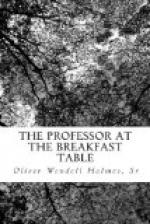So it was with this child. She had glanced off from her parental probabilities at an unexpected angle. Instead of taking to classical learning like her father, or sliding quietly into household duties like her mother, she broke out early in efforts that pointed in the direction of Art. As soon as she could hold a pencil she began to sketch outlines of objects round her with a certain air and spirit. Very extraordinary horses, but their legs looked as if they could move. Birds unknown to Audubon, yet flying, as it were, with a rush. Men with impossible legs, which did yet seem to have a vital connection with their most improbable bodies. By-and-by the doctor, on his beast,—an old man with a face looking as if Time had kneaded it like dough with his knuckles, with a rhubarb tint and flavor pervading himself and his sorrel horse and all their appurtenances. A dreadful old man! Be sure she did not forget those saddle-bags that held the detestable bottles out of which he used to shake those loathsome powders which, to virgin childish palates that find heaven in strawberries and peaches, are—Well, I suppose I had better stop. Only she wished she was dead sometimes when she heard him coming. On the next leaf would figure the gentleman with the black coat and white cravat, as he looked when he came and entertained her with stories concerning the death of various little children about her age, to encourage her, as that wicked Mr. Arouet said about shooting Admiral Byng. Then she would take her pencil, and with a few scratches there would be the outline of a child, in which you might notice how one sudden sweep gave the chubby cheek, and two dots darted at the paper looked like real eyes.
By-and-by she went to school, and caricatured the schoolmaster on the leaves of her grammars and geographies, and drew the faces of her companions, and, from time to time, heads and figures from her fancy, with large eyes, far apart, like those of Raffaelle’s mothers and children, sometimes with wild floating hair, and then with wings and heads thrown back in ecstasy. This was at about twelve years old, as the dates of these drawings show, and, therefore, three or four years before she came among us. Soon after this time, the ideal figures began to take the place of portraits and caricatures, and a new feature appeared in her drawing-books in the form of fragments of verse and short poems.
It was dull work, of course, for such a young girl to live with an old spinster and go to a village school. Her books bore testimony to this; for there was a look of sadness in the faces she drew, and a sense of weariness and longing for some imaginary conditions of blessedness or other, which began to be painful. She might have gone through this flowering of the soul, and, casting her petals, subsided into a sober, human berry, but for the intervention of friendly assistance and counsel.




